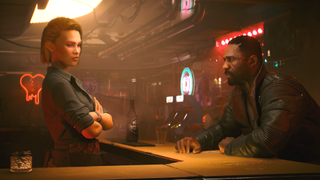Putting the roleplay back in the RPG was a huge reason for Cyberpunk 2077's recent metro and romance updates, says associate game director: 'It's easy to overlook'
The vibes are vital.

Cyberpunk 2077's 2.0 update was a huge overhaul for the game's RPG systems, arriving hand-in-hand with the stellar expansion Phantom Liberty. But you might've noticed that a lot of the post-launch patches were substantially less crunchy. A fully-functioning metro system, better romances—in other words, flavour and fluff.
According to associate game director Paweł Sasko, who spoke with PC Gamer's Ted Litchfield at GDC earlier this week, the choice to add texture to Night City was not only deliberate, it was an essential part of the RPG experience the team felt was missing:
"The 2.1 update that introduced the metro and a couple of other things, that was the update that was more-or-less roleplaying focused." Sasko adds that, while said features don't "add much to the game narratively", they were instead geared towards allowing players to just, well, vibe: "So many players pointed out to us that they wanted to spend more time in the game, just being in that world."
Sasko says that it's "one of the things we learned from '77, one of the lessons, is really like—those roleplaying elements? Super important." He and his team observed that Cyberpunk 2077, while being one of the most modded games on sites like Nexus Mods, was mostly tweaked to add more granular roleplay and customisation, like a survival-style mod that requires you to stay hydrated in between bouts of techno ultraviolence.
"When you're building a game, I think it's easy to overlook this, because you're thinking traditionally that the four pillars of an RPG are like: Combat, narrative, player/character progression, and exploration, right? And those are the main four pillars of RPGs, and how we traditionally look at them as an industry."
Yet, Sasko adds, "when you think about them, none of them are specifically about like, say, riding the Metro around." Despite this, the development team has grown a deep love and appreciation for vibes-based mechanical design over time. Sasko recounts wanting "this feeling that I'm going to the Metro station, and I have the Principalis radio station playing, I'm walking, I'm listening to the music… that's it.
"There's not much needed sometimes, [but] it's easy to overlook, so that's why we were doing 2.0. We wanted to address this."
PC Gamer Newsletter
Sign up to get the best content of the week, and great gaming deals, as picked by the editors.
I genuinely couldn't agree more—there's this ephemeral quality of actually existing in an RPG's world that's super dependent on the light touches that, to the untrained eye, seem 'pointless'. Does Cyberpunk 2077 need a fully functioning metro system when you've got fast travel? Not really, but having the option there lets players create moments of significance, playing a role they've created for themselves.

Harvey's history with games started when he first begged his parents for a World of Warcraft subscription aged 12, though he's since been cursed with Final Fantasy 14-brain and a huge crush on G'raha Tia. He made his start as a freelancer, writing for websites like Techradar, The Escapist, Dicebreaker, The Gamer, Into the Spine—and of course, PC Gamer. He'll sink his teeth into anything that looks interesting, though he has a soft spot for RPGs, soulslikes, roguelikes, deckbuilders, MMOs, and weird indie titles. He also plays a shelf load of TTRPGs in his offline time. Don't ask him what his favourite system is, he has too many.
- Ted LitchfieldAssociate Editor

FF14 and FF16 senior translator Koji Fox says 'you can kinda tell' game director Naoki Yoshida is 'like: I'm done with dark fantasy, I want to do something light again'

Baldur's Gate 3 player summons roughly 88 minions to conquer Honour Mode with a glorious army of spore zombies, elementals, and Scratch the best boy
Most Popular





